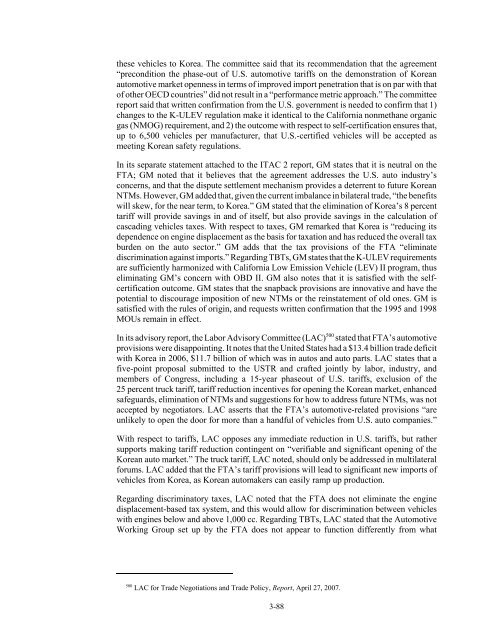U.S.-Korea Free Trade Agreement: Potential Economy-wide ... - USITC
U.S.-Korea Free Trade Agreement: Potential Economy-wide ... - USITC
U.S.-Korea Free Trade Agreement: Potential Economy-wide ... - USITC
Create successful ePaper yourself
Turn your PDF publications into a flip-book with our unique Google optimized e-Paper software.
these vehicles to <strong>Korea</strong>. The committee said that its recommendation that the agreement<br />
“precondition the phase-out of U.S. automotive tariffs on the demonstration of <strong>Korea</strong>n<br />
automotive market openness in terms of improved import penetration that is on par with that<br />
of other OECD countries” did not result in a “performance metric approach.” The committee<br />
report said that written confirmation from the U.S. government is needed to confirm that 1)<br />
changes to the K-ULEV regulation make it identical to the California nonmethane organic<br />
gas (NMOG) requirement, and 2) the outcome with respect to self-certification ensures that,<br />
up to 6,500 vehicles per manufacturer, that U.S.-certified vehicles will be accepted as<br />
meeting <strong>Korea</strong>n safety regulations.<br />
In its separate statement attached to the ITAC 2 report, GM states that it is neutral on the<br />
FTA; GM noted that it believes that the agreement addresses the U.S. auto industry’s<br />
concerns, and that the dispute settlement mechanism provides a deterrent to future <strong>Korea</strong>n<br />
NTMs. However, GM added that, given the current imbalance in bilateral trade, “the benefits<br />
will skew, for the near term, to <strong>Korea</strong>.” GM stated that the elimination of <strong>Korea</strong>’s 8 percent<br />
tariff will provide savings in and of itself, but also provide savings in the calculation of<br />
cascading vehicles taxes. With respect to taxes, GM remarked that <strong>Korea</strong> is “reducing its<br />
dependence on engine displacement as the basis for taxation and has reduced the overall tax<br />
burden on the auto sector.” GM adds that the tax provisions of the FTA “eliminate<br />
discrimination against imports.” Regarding TBTs, GM states that the K-ULEV requirements<br />
are sufficiently harmonized with California Low Emission Vehicle (LEV) II program, thus<br />
eliminating GM’s concern with OBD II. GM also notes that it is satisfied with the selfcertification<br />
outcome. GM states that the snapback provisions are innovative and have the<br />
potential to discourage imposition of new NTMs or the reinstatement of old ones. GM is<br />
satisfied with the rules of origin, and requests written confirmation that the 1995 and 1998<br />
MOUs remain in effect.<br />
In its advisory report, the Labor Advisory Committee (LAC) 500 stated that FTA’s automotive<br />
provisions were disappointing. It notes that the United States had a $13.4 billion trade deficit<br />
with <strong>Korea</strong> in 2006, $11.7 billion of which was in autos and auto parts. LAC states that a<br />
five-point proposal submitted to the USTR and crafted jointly by labor, industry, and<br />
members of Congress, including a 15-year phaseout of U.S. tariffs, exclusion of the<br />
25 percent truck tariff, tariff reduction incentives for opening the <strong>Korea</strong>n market, enhanced<br />
safeguards, elimination of NTMs and suggestions for how to address future NTMs, was not<br />
accepted by negotiators. LAC asserts that the FTA’s automotive-related provisions “are<br />
unlikely to open the door for more than a handful of vehicles from U.S. auto companies.”<br />
With respect to tariffs, LAC opposes any immediate reduction in U.S. tariffs, but rather<br />
supports making tariff reduction contingent on “verifiable and significant opening of the<br />
<strong>Korea</strong>n auto market.” The truck tariff, LAC noted, should only be addressed in multilateral<br />
forums. LAC added that the FTA’s tariff provisions will lead to significant new imports of<br />
vehicles from <strong>Korea</strong>, as <strong>Korea</strong>n automakers can easily ramp up production.<br />
Regarding discriminatory taxes, LAC noted that the FTA does not eliminate the engine<br />
displacement-based tax system, and this would allow for discrimination between vehicles<br />
with engines below and above 1,000 cc. Regarding TBTs, LAC stated that the Automotive<br />
Working Group set up by the FTA does not appear to function differently from what<br />
500 LAC for <strong>Trade</strong> Negotiations and <strong>Trade</strong> Policy, Report, April 27, 2007.<br />
3-88

















